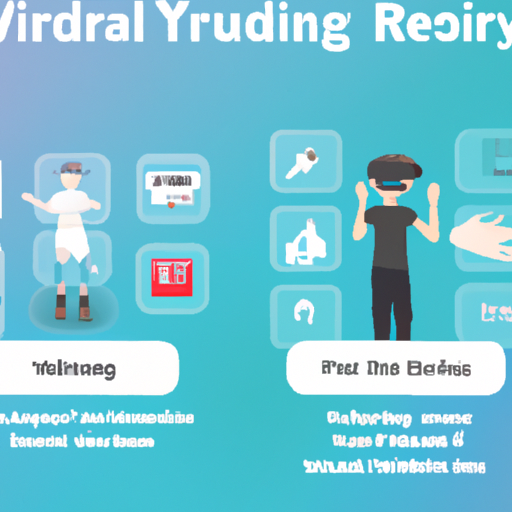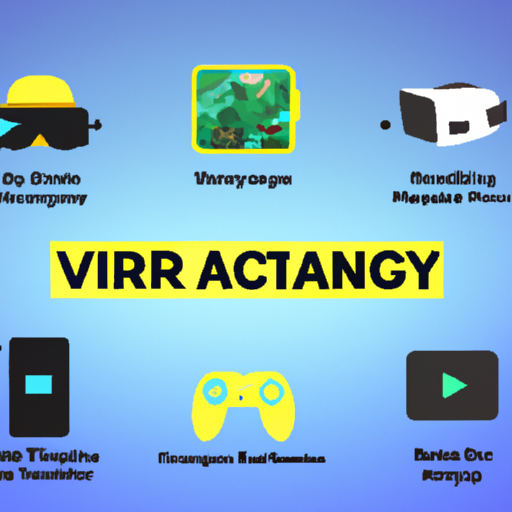-
Table of Contents
“Experience the Future of Entertainment with VR/AR!”
Introduction
Virtual Reality (VR) and Augmented Reality (AR) have revolutionized the entertainment industry, from gaming to movies. VR and AR have opened up a world of possibilities for gamers and moviegoers alike, allowing them to experience immersive, interactive, and realistic worlds. With VR, gamers can explore virtual worlds and engage in thrilling adventures, while AR allows them to interact with their environment in a more natural way. Movies have also been enhanced by VR and AR, allowing viewers to experience the story in a more immersive way. With the help of VR and AR, the entertainment industry has been able to create more engaging and realistic experiences for its audiences.
How VR/AR is Enhancing Immersive Experiences in Gaming and Movies
Virtual reality (VR) and augmented reality (AR) are revolutionizing the way we experience gaming and movies. By creating immersive, interactive environments, these technologies are allowing us to explore new worlds and engage with characters in ways that were previously impossible.
VR and AR are being used to create incredibly realistic gaming experiences. By using headsets and motion controllers, gamers can explore virtual worlds and interact with characters in a way that feels incredibly lifelike. This technology is also being used to create interactive movie experiences. By using headsets and motion controllers, viewers can explore virtual sets and interact with characters in a way that feels like they are actually part of the movie.
VR and AR are also being used to create more immersive experiences in gaming and movies. By using 3D audio, haptic feedback, and motion tracking, these technologies are allowing us to feel like we are actually in the game or movie. This is especially true for horror games and movies, where the use of 3D audio and haptic feedback can create a truly terrifying experience.
Finally, VR and AR are being used to create more interactive experiences in gaming and movies. By using voice commands, gesture recognition, and eye tracking, these technologies are allowing us to interact with characters and objects in a way that feels natural and intuitive. This is especially true for puzzle games and adventure movies, where the use of voice commands and gesture recognition can create a truly engaging experience.
Overall, VR and AR are revolutionizing the way we experience gaming and movies. By creating immersive, interactive environments, these technologies are allowing us to explore new worlds and engage with characters in ways that were previously impossible. As these technologies continue to evolve, we can expect to see even more immersive and interactive experiences in gaming and movies.
The Impact of VR/AR on the Entertainment Industry
The entertainment industry is constantly evolving, and the introduction of virtual reality (VR) and augmented reality (AR) technologies has been a major game-changer. VR and AR have the potential to revolutionize the way people experience entertainment, and the industry is already beginning to take advantage of these technologies.
VR and AR offer a unique way to experience entertainment. With VR, users can be fully immersed in a virtual world, while AR allows them to interact with digital objects in the real world. This opens up a world of possibilities for the entertainment industry, from interactive movies and video games to virtual concerts and theme parks.
VR and AR can also be used to create more immersive experiences. For example, VR can be used to create virtual movie theaters, allowing viewers to watch films in a realistic environment. AR can be used to create interactive experiences, such as augmented reality games or interactive museum exhibits.
The entertainment industry is also beginning to explore the potential of VR and AR for marketing and advertising. Companies can use these technologies to create unique and engaging experiences for their customers, such as virtual product demonstrations or interactive ads.
Finally, VR and AR can be used to create new forms of entertainment. For example, VR can be used to create virtual reality concerts, allowing fans to experience a live performance from the comfort of their own home. AR can be used to create interactive experiences, such as augmented reality games or interactive museum exhibits.
Overall, VR and AR have the potential to revolutionize the entertainment industry. These technologies offer a unique way to experience entertainment, and they can be used to create more immersive experiences, new forms of entertainment, and more engaging marketing and advertising campaigns. As the technology continues to evolve, the possibilities are endless.
Exploring the Possibilities of VR/AR in Gaming
The gaming industry has seen a tremendous amount of growth over the past few years, and the introduction of virtual reality (VR) and augmented reality (AR) technology has only added to the excitement. VR and AR have the potential to revolutionize the gaming experience, allowing players to immerse themselves in a virtual world and interact with it in ways that were previously impossible.
VR and AR technology can be used to create incredibly realistic and immersive gaming experiences. With VR, players can explore virtual worlds in a way that feels almost like being there in person. AR, on the other hand, can be used to overlay virtual objects onto the real world, allowing players to interact with them in a more natural way.
The possibilities for VR and AR in gaming are virtually limitless. For example, VR could be used to create a virtual world that is completely interactive, allowing players to explore and interact with the environment in a way that is not possible in traditional gaming. AR could be used to create a more realistic gaming experience, with virtual objects that appear to be part of the real world.
In addition to creating more immersive gaming experiences, VR and AR technology can also be used to create more social gaming experiences. For example, VR could be used to create virtual worlds where players can interact with each other in a more natural way. AR could be used to create virtual objects that can be shared between players, allowing them to collaborate on projects or compete against each other in real-time.
The potential for VR and AR in gaming is truly exciting, and it is only just beginning to be explored. As the technology continues to develop, we can expect to see more and more innovative uses for it in the gaming industry. It is an exciting time for gamers, and the possibilities for VR and AR in gaming are truly limitless.
How VR/AR is Changing the Way We Experience Movies
The movie industry has been revolutionized by the introduction of virtual reality (VR) and augmented reality (AR) technologies. These technologies have enabled viewers to experience movies in a completely new way, immersing them in the story and allowing them to interact with the characters and environment.
VR and AR have opened up a world of possibilities for filmmakers. With these technologies, filmmakers can create immersive experiences that draw viewers into the story and make them feel as if they are part of the action. For example, viewers can now explore a movie’s environment in 360-degree virtual reality, or interact with characters and objects in augmented reality.
VR and AR have also enabled filmmakers to create interactive experiences that allow viewers to influence the story. For example, viewers can now make choices that affect the outcome of the movie, or even control the characters’ actions. This has opened up a whole new world of possibilities for filmmakers, allowing them to create unique and engaging stories.
In addition, VR and AR have enabled filmmakers to create more realistic and immersive experiences. For example, viewers can now experience a movie in 3D, or even in 4D, with the addition of tactile feedback and other sensory elements. This has allowed filmmakers to create more realistic and engaging experiences that draw viewers into the story.
Finally, VR and AR have enabled filmmakers to create more interactive experiences. For example, viewers can now use their own body movements to control the characters in the movie, or even interact with the environment. This has allowed filmmakers to create more engaging and interactive experiences that draw viewers into the story.
Overall, VR and AR have revolutionized the way we experience movies. These technologies have enabled filmmakers to create more immersive and interactive experiences that draw viewers into the story and make them feel as if they are part of the action. As these technologies continue to evolve, we can expect to see even more innovative and engaging experiences in the future.
Conclusion
In conclusion, VR/AR technology has revolutionized the entertainment industry, particularly in gaming and movies. It has enabled users to experience a more immersive and interactive experience, and has opened up new possibilities for storytelling and game design. As the technology continues to evolve, it is likely that VR/AR will continue to be a major part of the entertainment industry for years to come.




